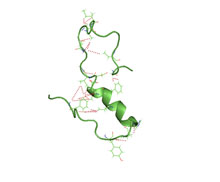Protein KIBRA also known as kidney and brain expressed protein (KIBRA) or WW domain-containing protein 1 (WWC1) is a protein that in humans is encoded by the WWC1 gene. [5] [6] [7]
Protein KIBRA also known as kidney and brain expressed protein (KIBRA) or WW domain-containing protein 1 (WWC1) is a protein that in humans is encoded by the WWC1 gene. [5] [6] [7]
A single nucleotide polymorphism (rs17070145) [8] in the gene has been associated with human memory performance and cognitive ability in various studies since 2006. While no significant support for KIBRA's association with memory was found in a 2008 study with 584 subjects, [9] the original 2006 study was replicated in a smaller sample of an elderly population in 2008 [10] Two subsequent studies in 2009 in indicated that KIBRA is specifically associated with forgetting of non-semantic material as well as cognitive flexibility among smokers and non-smokers. [11] KIBRA SNPs have been shown to increase hippocampal volume and affect spatial ability and scientific achievement. [12] [13]
Studies have also begun to investigate the role of KIBRA in Alzheimer's disease. [14]
KIBRA has at least 10 interaction partners, including synaptopodin, PKCζ and Dendrin, most of which modify synaptic plasticity. For instance, Dendrin is a post-synaptic protein with expression regulated by sleep deprivation. [15] KIBRA has been shown to interact with Protein kinase Mζ. [16]

The tau proteins are a group of six highly soluble protein isoforms produced by alternative splicing from the gene MAPT. They have roles primarily in maintaining the stability of microtubules in axons and are abundant in the neurons of the central nervous system (CNS), where the cerebral cortex has the highest abundance. They are less common elsewhere but are also expressed at very low levels in CNS astrocytes and oligodendrocytes.

Amyloid beta denotes peptides of 36–43 amino acids that are the main component of the amyloid plaques found in the brains of people with Alzheimer's disease. The peptides derive from the amyloid-beta precursor protein (APP), which is cleaved by beta secretase and gamma secretase to yield Aβ in a cholesterol-dependent process and substrate presentation. Aβ molecules can aggregate to form flexible soluble oligomers which may exist in several forms. It is now believed that certain misfolded oligomers can induce other Aβ molecules to also take the misfolded oligomeric form, leading to a chain reaction akin to a prion infection. The oligomers are toxic to nerve cells. The other protein implicated in Alzheimer's disease, tau protein, also forms such prion-like misfolded oligomers, and there is some evidence that misfolded Aβ can induce tau to misfold.

Neurofibrillary tangles (NFTs) are intracellular aggregates of hyperphosphorylated tau protein that are most commonly known as a primary biomarker of Alzheimer's disease. Their presence is also found in numerous other diseases known as tauopathies. Little is known about their exact relationship to the different pathologies.

Major prion protein(PrP) is encoded in the human body by the PRNP gene also known as CD230 (cluster of differentiation 230). Expression of the protein is most predominant in the nervous system but occurs in many other tissues throughout the body.

Apolipoprotein E (Apo-E) is a protein involved in the metabolism of fats in the body of mammals. A subtype is implicated in the Alzheimer's disease and cardiovascular diseases. It is encoded in humans by the gene APOE.
The biochemistry of Alzheimer's disease, the most common cause of dementia, is not yet very well understood. Alzheimer's disease (AD) has been identified as a proteopathy: a protein misfolding disease due to the accumulation of abnormally folded amyloid beta (Aβ) protein in the brain. Amyloid beta is a short peptide that is an abnormal proteolytic byproduct of the transmembrane protein amyloid-beta precursor protein (APP), whose function is unclear but thought to be involved in neuronal development. The presenilins are components of proteolytic complex involved in APP processing and degradation.

Sortilin-related receptor, L(DLR class) A repeats containing is a protein that in humans is encoded by the SORL1 gene.

Neurogranin is a calmodulin-binding protein expressed primarily in the brain, particularly in dendritic spines, and participating in the protein kinase C signaling pathway. Neurogranin is the main postsynaptic protein regulating the availability of calmodulin, binding to it in the absence of calcium. Phosphorylation by protein kinase C lowers its binding ability. NRGN gene expression is controlled by thyroid hormones. Human neurogranin consists of 78 amino acids.

Profilin-1 is a protein that in humans is encoded by the PFN1 gene.

Kalirin, also known as Huntingtin-associated protein-interacting protein (HAPIP), protein duo (DUO), or serine/threonine-protein kinase with Dbl- and pleckstrin homology domain, is a protein that in humans is encoded by the KALRN gene. Kalirin was first identified in 1997 as a protein interacting with huntingtin-associated protein 1. Is also known to play an important role in nerve growth and axonal development.

Polyglutamine-binding protein 1 (PQBP1) is a protein that in humans is encoded by the PQBP1 gene.

ATP-binding cassette sub-family A member 7 is a protein that in humans is encoded by the ABCA7 gene.

Kinesin family member 5A is a protein that in humans is encoded by the KIF5A gene. It is part of the kinesin family of motor proteins.

Triggering receptor expressed on myeloid cells 2(TREM2) is a protein that in humans is encoded by the TREM2 gene. TREM2 is expressed on macrophages, immature monocyte-derived dendritic cells, osteoclasts, and microglia, which are immune cells in the central nervous system. In the liver, TREM2 is expressed by several cell types, including macrophages, that respond to injury. In the intestine, TREM2 is expressed by myeloid-derived dendritic cells and macrophage. TREM2 is overexpressed in many tumor types and has anti-inflammatory activities. It might therefore be a good therapeutic target.

Calmodulin-binding transcription activator 1 is a protein that in humans is encoded by the CAMTA1 gene.

Translocase of outer mitochondrial membrane 40 homolog (yeast), also known as TOMM40, is a protein which in humans is encoded by the TOMM40 gene.

Cip1-interacting zinc finger protein is a protein that in humans is encoded by the CIZ1 gene.

Cilia- and flagella-associated protein 298 is a protein encoded by CFAP298 gene. It is of interest in part for its association with various diseases. It has been found in high levels in the bone marrow of patients with a negative prognosis of acute myeloid leukemia and an abnormal karyotype. Male Alzheimer's patients have shown a decrease in expression of CFAP298 in their blood cells. The CFAP298 gene lies within the critical region of Down Syndrome. There are no clear paralogs in humans, but the gene has homologues widely conserved among animals, fungi, and algae.

Iroquois-class homeodomain protein IRX-2, also known as Iroquois homeobox protein 2, is a protein that in humans is encoded by the IRX2 gene.

Leukocyte immunoglobulin-like receptor subfamily A member 5 (LILR-A5) also known as CD85 antigen-like family member F (CD85f), immunoglobulin-like transcript 11 (ILT-11), and leukocyte immunoglobulin-like receptor 9 (LIR-9) is a protein that in humans is encoded by the LILRA5 gene. This gene is one of the leukocyte receptor genes that form a gene cluster on the chromosomal region 19q13.4. Four alternatively spliced transcript variants encoding distinct isoforms have been described.